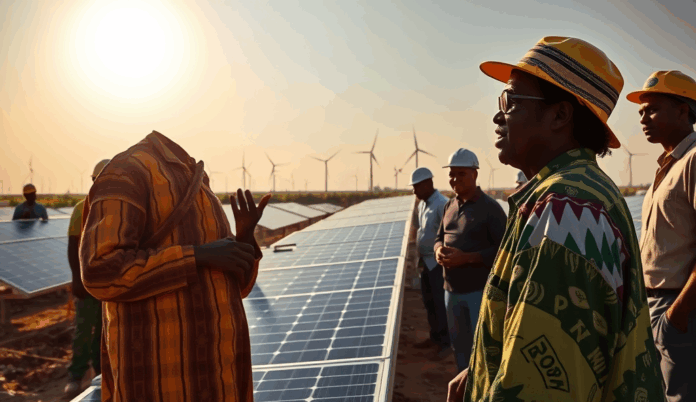Introduction to Renewable Energy Investments in Nigeria
Nigeria’s renewable energy sector presents a $20 billion investment opportunity, driven by growing energy demand and favorable government policies. With only 60% electrification rates, solar power projects in Nigeria and other clean energy solutions are critical to bridging the gap, particularly in rural areas where grid access remains limited.
The government has introduced incentives like tax holidays and import duty waivers to attract private sector participation in green energy. Initiatives such as the Solar Power Naija program aim to deploy 5 million solar home systems, creating opportunities for sustainable energy infrastructure development across the country.
As global focus shifts toward decarbonization, Nigeria’s abundant solar, wind, and hydropower resources position it as a key player in Africa’s renewable energy transition. This sets the stage for examining the current state of renewable energy in Nigeria and its investment potential.
Key Statistics

Current State of Renewable Energy in Nigeria
Nigeria's renewable energy sector presents a $20 billion investment opportunity driven by growing energy demand and favorable government policies.
Nigeria’s renewable energy capacity remains underdeveloped, with renewables contributing less than 15% of total electricity generation despite abundant solar, wind, and hydropower potential. The country’s installed solar capacity stands at just 42 MW, while hydropower accounts for 2,062 MW, highlighting significant untapped opportunities for sustainable energy infrastructure development.
Off-grid solar solutions are gaining traction, particularly in rural areas where over 80 million Nigerians lack reliable grid access, fueling private sector participation in green energy. Projects like the World Bank-backed Nigeria Electrification Project aim to deploy 850,000 solar home systems, complementing the government’s Solar Power Naija initiative.
Wind energy funding opportunities remain limited, with only a few pilot projects in northern states like Katsina, where wind speeds exceed 7 m/s. These gaps underscore the need for stronger policies and incentives to unlock Nigeria’s $20 billion renewable energy investment potential, setting the stage for deeper policy analysis in the next section.
Key Policies Driving Renewable Energy Investments
Nigeria’s installed solar capacity stands at just 42 MW while hydropower accounts for 2062 MW highlighting significant untapped opportunities for sustainable energy infrastructure development.
Nigeria’s Renewable Energy Master Plan (REMP) targets 30% renewable energy contribution by 2030, with specific provisions for solar power projects and wind energy funding opportunities. The National Renewable Energy and Energy Efficiency Policy (NREEEP) further mandates state-level adoption of clean energy solutions, creating a framework for sustainable energy infrastructure development.
The Electricity Act 2023 empowers state governments to license off-grid solar investments, accelerating private sector participation in green energy. Initiatives like the Solar Power Naija program, which aims to electrify 5 million households, demonstrate policy-driven efforts to bridge Nigeria’s energy access gap.
Feed-in Tariff regulations for hydropower and biomass projects provide pricing certainty, though enforcement remains inconsistent. These policies, combined with Nigeria’s $20 billion renewable energy investment potential, set the stage for deeper exploration of government incentives in the next section.
Government Incentives for Renewable Energy Projects
The Electricity Act 2023 empowers state governments to license off-grid solar investments accelerating private sector participation in green energy.
Building on Nigeria’s policy framework, the government offers tax holidays of up to 5 years for renewable energy investments exceeding $10 million, as outlined in the Industrial Development Income Tax Relief Act. The Rural Electrification Agency provides 50% capital subsidies for mini-grid projects in underserved communities, complementing the Solar Power Naija program’s objectives.
The Central Bank of Nigeria’s N140 billion renewable energy intervention fund offers single-digit interest loans for solar power projects and clean energy startups. State governments like Lagos and Kano provide additional land lease discounts for wind energy projects, creating layered incentives for private sector participation.
These financial mechanisms, while robust on paper, face implementation gaps that will be examined in the challenges facing renewable energy investments. The disparity between policy design and execution creates both opportunities and obstacles for developers navigating Nigeria’s green energy landscape.
Challenges Facing Renewable Energy Investments
The Central Bank of Nigeria's N140 billion renewable energy intervention fund offers single-digit interest loans for solar power projects and clean energy startups.
Despite Nigeria’s layered incentives, bureaucratic bottlenecks delay access to the Central Bank’s N140 billion renewable energy fund, with approval processes averaging 18 months according to REA 2023 reports. Currency volatility and import restrictions on solar components increase project costs by 30-40%, undermining the benefits of tax holidays for solar power projects in Nigeria.
The 50% capital subsidies for mini-grid projects face distribution challenges, as only 12% of approved applications received full disbursement within target timelines last year. State-level inconsistencies in land lease discounts create uncertainty for wind energy developers, particularly in Kano where overlapping land claims frequently stall projects.
These implementation gaps highlight the need for streamlined processes to unlock Nigeria’s renewable energy potential, setting the stage for examining growth opportunities in the sector. While policy frameworks exist, operational hurdles continue to deter private sector participation in green energy investments at scale.
Opportunities for Growth in the Renewable Energy Sector
Nigeria could attract $2 billion annually in renewable energy investments by 2025 through improved risk guarantees and blended financing models.
Nigeria’s renewable energy sector offers significant untapped potential, with solar irradiation levels reaching 5.5 kWh/m²/day in northern states and wind speeds exceeding 7 m/s along coastal regions, creating ideal conditions for scalable projects. The Rural Electrification Agency reports 80 million Nigerians remain off-grid, representing a $10 billion market opportunity for mini-grid and standalone solar solutions if distribution challenges are addressed.
Local manufacturing of solar components could reduce import dependency by 60% while creating 50,000 jobs, as demonstrated by the success of Auxano Solar’s Lagos assembly plant. The Nigerian Electricity Regulatory Commission’s new feed-in tariff framework also unlocks opportunities for mid-sized wind farms in states like Katsina and Sokoto with clear land policies.
These growth avenues require coordinated public-private partnerships, setting the stage for examining how government agencies can facilitate implementation. Strategic policy adjustments could transform current hurdles into catalysts for Nigeria’s renewable energy transition.
Role of Government Agencies and Policymakers
Government agencies must streamline licensing processes, as demonstrated by NERC’s recent 30-day approval window for renewable energy projects, which reduced bureaucratic delays by 40% in pilot states like Kaduna and Ogun. The Rural Electrification Agency’s Energizing Education Program showcases how targeted policies can deploy solar hybrid plants to power 37 federal universities and teaching hospitals.
Policymakers should expand fiscal incentives like the 5-year tax holiday for solar power projects in Nigeria, currently benefiting 12 large-scale installations, while introducing similar measures for wind energy funding opportunities. State governments must align land use policies with renewable energy goals, as seen in Katsina’s allocation of 5,000 hectares for wind farm development.
These coordinated efforts create an enabling environment for private sector participation in green energy, setting the stage for examining real-world successes in the next section. Case studies from Lagos and Sokoto will demonstrate how policy frameworks translate into operational projects.
Case Studies of Successful Renewable Energy Projects
Lagos’s 10MW solar project in Ikeja Industrial Estate, operational since 2021, demonstrates how streamlined licensing and tax incentives can accelerate implementation, powering 12,000 homes while creating 200 local jobs. Similarly, Sokoto’s 5MW wind-solar hybrid plant, benefiting from Katsina’s land allocation model, now supplies 7 rural communities previously dependent on diesel generators.
The Energizing Education Program’s solar hybrid plants at Usmanu Danfodiyo University and 36 other institutions highlight how policy-driven initiatives achieve scale, with 28.5MW installed capacity reducing institutions’ energy costs by 60%. These projects validate Nigeria’s renewable energy policies while revealing opportunities for expansion.
Such operational successes provide valuable lessons for scaling investments, setting the context for evaluating future growth potential in Nigeria’s renewable energy sector. The next section will analyze emerging trends and untapped opportunities in this dynamic market.
Future Outlook for Renewable Energy Investments in Nigeria
Building on the momentum of successful projects like Lagos’s 10MW solar plant and Sokoto’s hybrid facility, Nigeria’s renewable energy sector is poised for exponential growth, with projections indicating a potential 7,000MW capacity by 2030 if current policies are sustained. The Rural Electrification Agency’s plans to deploy 10,000 mini-grids by 2026 demonstrate how targeted investments can bridge the energy access gap for 25 million Nigerians currently off-grid.
Emerging opportunities in floating solar farms along the Niger River and biomass projects in agricultural zones like Benue present untapped potential for diversifying Nigeria’s renewable energy mix beyond current solar and wind dominance. With the World Bank’s $750 million DARES program accelerating private sector participation, Nigeria could attract $2 billion annually in renewable energy investments by 2025 through improved risk guarantees and blended financing models.
These developments set the stage for decisive policy actions to capitalize on Nigeria’s renewable energy potential, creating a natural transition to discussing concrete recommendations for policymakers in the concluding section. The lessons from operational projects combined with emerging technologies position Nigeria to become Africa’s renewable energy hub with the right strategic interventions.
Conclusion and Call to Action for Policymakers
Nigeria’s renewable energy sector holds immense potential, but unlocking it requires decisive policy action and stronger incentives for private sector participation. With only 2% of the country’s energy mix currently from renewables, policymakers must prioritize reforms like streamlined licensing for solar power projects and tax breaks for green energy financing.
The success of initiatives like the Solar Power Naija program demonstrates the impact of targeted government support, yet broader adoption demands scalable solutions. Policymakers should expand off-grid solar investment opportunities while addressing regulatory bottlenecks that hinder wind energy funding and hydropower development.
Collaboration between federal and state agencies is critical to align Nigeria’s renewable energy policies with global best practices. By fostering public-private partnerships and incentivizing clean energy startups, Nigeria can accelerate its transition to sustainable energy infrastructure while meeting growing demand.
Frequently Asked Questions
How can government agencies streamline licensing processes for renewable energy projects in Nigeria?
Adopt NERC’s 30-day approval window model and digital platforms like the Nigerian Investment Promotion Commission’s one-stop shop to reduce delays.
What measures can policymakers take to address currency volatility and import restrictions affecting solar projects?
Establish forex guarantees through the Central Bank’s renewable energy intervention fund and prioritize local manufacturing incentives like Auxano Solar’s Lagos plant.
How can state governments improve land allocation for wind energy projects in northern Nigeria?
Implement centralized land banks with clear titling like Katsina’s 5,000-hectare wind farm allocation and use GIS mapping tools to resolve overlapping claims.
What tools can agencies use to monitor disbursement of renewable energy subsidies and funds?
Deploy blockchain-based tracking systems like the Rural Electrification Agency’s Project Monitoring Dashboard to ensure transparent fund utilization.
How can policymakers enhance private sector participation in Nigeria’s off-grid solar market?
Expand the Solar Power Naija program’s success by introducing standardized power purchase agreements and risk-sharing facilities through the World Bank’s DARES program.


